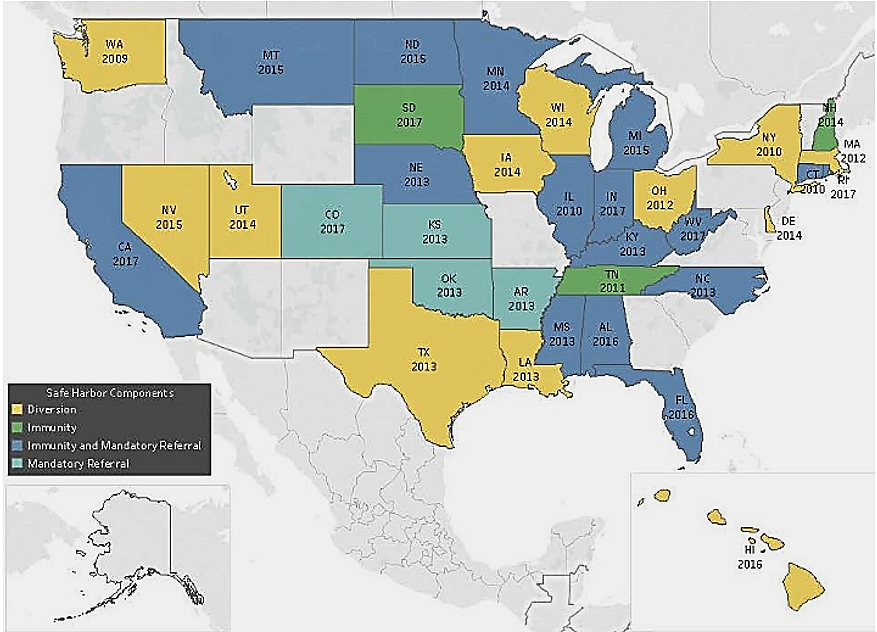Over the past decade, safe harbor laws for young victims of commercial sexual exploitation have proliferated at the state level. These laws are designed to protect youth from punitive sanctions and instead refer them to youth-serving agencies that can provide supportive services. The laws are based on the premise that these crimes should be understood as acts of abuse and violence against youth and that minors who are exploited commercially for sexual purposes should not be considered criminals, but rather victims and survivors.
OJJDP recently released the findings of a study that examined safe harbor laws in the United States. Conducted by Development Services Group, Inc., the three-phase study examined the evolution of safe harbor laws and quantitatively and qualitatively assessed the laws’ impact on the commercial sexual exploitation of children (CSEC).
The report’s discussion of phase 1 includes findings on state-level efforts to adopt these laws. Researchers coded the applicable legislation from all 50 states according to the three basic elements of a safe harbor law—immunity from prosecution, diversion from the juvenile justice system, and mandatory referral to services—and 8 other components commonly associated with safe harbor laws (demand-side penalties, trafficker penalties, the use of wiretapping to provide corroborating evidence, specialized training for first responders, a CSEC task force, specialized victim services, the opportunity for victims to seek civil damages, and the possibility of vacating convictions). They then integrated the coding of each state into one of the most detailed and comprehensive datasets available on this topic. Following are highlights of their findings:
- By the end of 2017, 35 states had enacted safe harbor statutes to remove punitive sanctions for CSEC victims. Fifteen states still allow the arrest and prosecution of minors who are victims of commercial sexual exploitation and sex trafficking (see map below).
- The most popular method of implementing a safe harbor law is through immunity from prosecution with mandatory referral to services and treatment (16 states), followed by diversion from the juvenile justice system (12 states), mandatory referral only (4 states), and immunity only (3 states).
- As of 2017, 41 states had enacted legislation that makes penalties for the buyers of commercial sex acts with minors as severe as federal penalties for this crime, and every state except New Mexico has enacted statutes that mandate penalties for traffickers that are as severe as federal penalties.
- Thirty states have adopted statutes establishing a state-mandated task force, commission, or advisory committee dedicated to addressing human trafficking.
- Twenty-one states have statutes mandating training for first responders on the identification and handling of sex trafficking victims.
Safe Harbor Laws Across the United States

As shown above, 12 states have implemented a safe harbor law through diversion from the juvenile justice system, 3 states use immunity from prosecution only, 16 states use immunity from prosecution with mandatory referral to services and treatment, and 4 states use mandatory referral only.
In phase 2, researchers conducted a quantitative assessment to compare counties that have implemented safe harbor laws with those that have not. Researchers found that the enactment of safe harbor laws had little impact on the number of prostitution-related crimes. However, the passage of safe harbor laws was associated with a statistically significant decline in the number of prostitution-related arrests in counties that have enacted safe harbor legislation relative to those that have not. Specifically, while the total number of prostitution-related arrests dropped in both safe harbor and non-safe harbor states from 2009 through 2015, the decline was steeper for jurisdictions with safe harbor legislation than for jurisdictions without this legislation.
In contrast, investigators found no evidence that youth were systematically being reclassified as victims of sexual abuse and referred to appropriate services. Overall, these findings indicate that the enactment of safe harbor laws did result in fewer prostitution-related arrests, but they did little to prevent the abuse from happening in towns, cities, and neighborhoods throughout the United States.
Researchers in phase 3 interviewed key stakeholders in two states—one state that implemented safe harbor laws with positive findings, and one that implemented these laws with no positive results. In both cases, interviewees felt that safe harbor laws had a positive impact on children as well as the professionals who are responsible for enforcing the law and providing care. At the same time, interviewees almost unanimously emphasized the continuing challenges in providing CSEC victims with specialized services to help them heal and exit the life of commercial sexual exploitation.
The report recommends a comprehensive and holistic approach to commercial sexual exploitation and trafficking that addresses both supply and demand. In addition, the report recommends that future research examine other effective systems of care (e.g., substance abuse treatment) to determine how best to facilitate access to specialized services.
It also identifies several components of successful implementation of safe harbor laws: leadership from the state law enforcement agency, a state coordinating body that is mandated—and empowered—to address CSEC, a concerted effort to redefine children involved in sex trafficking as victims rather than criminals as a means of motivating law enforcement, and planning to ensure that the necessary financial resources are in place to make the intent of safe harbor laws a reality.
Resources:
For a summary of the Office’s work to combat child sex trafficking, access the OJJDP In Focus page, Commercial Sexual Exploitation of Children.
